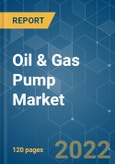The continued increase in the demand for oil owing to the increasing population and industrialization has fostered the growth in demand for the pumps for various applications in the oil & gas industry. According to IEA, the global oil demand in the 3rd quarter of 2019 increased by 1.1 mb/d year-on-year (y-o-y), more than double of 435 kb/d seen in the 2nd quarter 2019. China’s demand increased by 640 kb/d y-o-y in 3Q19. The global oil demand is expected to grow at a CAGR of 1.38% during the forecast period which is expected to drive the demand for pumps for application in refineries and exploration activities. However, the stringent government regulations and policies to reduce the carbon emission are likely to restrain the growth in oil & gas demand and thereby restrain the growth of the market studied during the forecast period.
Key Highlights
- The dynamic pumps are widely used in the oil & gas sector and centrifugal pumps dominates the market. These pumps are widely used for hydrocarbon processing, refineries, water injection, and pipeline services, and with the increase in the refining capacity in the coming years, the demand for the centrifugal pumps is likely to increase.
- Moreover, the technological development which has rendered the deepwater and ultra-deepwater exploration feasible and cost-effective is expected to increase oil production over the forecast period. This, in turn, is expected to create an an opportunity for market growth in the near future.
- Asia-Pacific has dominated the market in 2018, with the majority of demand coming from China, and India.
Key Market Trends
Increasing Demand for Dynamic Pumps (Centrifugal pumps) from Refineries
- Centrifugal pumps has a vast application in refineries and is used to transport petroleum and its derived products in refineries.
- The global refining capacity increased by 2.8% in 2018, which is likely to continue over the forecast period. The increase in the refining capacity globally has increased the demand for centrifugal pumps in refineries and is expected to continue over the forecast period.
- As of 2018, there were above 470 planned and announced petrochemical plants, out of which China is expected to have 240 plants with a total capacity of around 100 MTPA by 2026. The capital expenditure for the projects in China accounted for about USD 52 billion.
- Furthermore, with the IMO 2020 regulation being enforced from the 1st January 2020, the increasing demand for the low sulfur fuel is likely to force major refiners to upgrade the existing infrastructure to produce low sulfur fuels. With the refineries expected to go through revamp, the demand for pumps is likely to increase over the next few years, further driving the growth of the market.
Asia-Pacific Region Dominated the Market
- China is expected to account for the significant growth in crude oil refining capacity between 2019 and 2025 in Asia-Pacific region. The country is expected to account for 26.8% of the total refining expansion capacity in APAC by 2025.
- Also, India’s refining capacity has witnessed a CAGR of 3.36% between 2009 and 2018. As of August 2018, India Oil Corp., India’s largest refining company, had plans to increase its refining capacity from 80.7 million metric tons per annum to 150 million metric tons per annum by 2030. Additionally, Projects worth INR 320 billion are in various stages of execution.
- Adding to this, South-East Asia is also witnessing the commissioning of several refinery projects, including the expansion of existing ones and developing new ones to reduce the dependency on imports.
- The oil & gas industries, apart from being a source for the majority of primary energy consumption, also aids in providing raw materials for various industries such as petrochemical, solvents, fertilizers, and many others. With the growing population and rapid urbanization, the demand for these is likely to increase, promulgating the refiners to set up new plants or undergo expansion. This, in turn, is expected to create a significant
Competitive Landscape
The oil & gas pump market is fragmented. Some of the key companies operating in the market include Xylem Inc., Flowserve Corporation, KSB SE & Co. KGaA, Alfa Laval AB, and Gardner Denver Holdings Inc
Additional Benefits:
- The market estimate (ME) sheet in Excel format
- 3 months of analyst support
This product will be delivered within 2 business days.
Table of Contents
Companies Mentioned (Partial List)
A selection of companies mentioned in this report includes, but is not limited to:
- Xylem Inc.
- Flowserve Corporation
- Weir Group PLC
- Sulzer AG
- Alfa Laval AB
- Grundfos Holding A/S
- KSB SE & Co. KGaA
- ITT Inc.
- Gardner Denver Holdings Inc
- Baker Hughes Co








